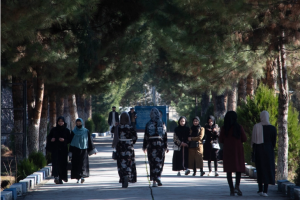Afghanistan’s main universities have reopened six months after the Taliban returned to power, but only a trickle of women have returned to now-segregated classes.
Most secondary schools for girls and all public universities were shuttered following the Taliban’s August 15 takeover, sparking fears women would be barred from education – as happened during the first rule of the Taliban, from 1996-2001.
The Taliban insist they will allow girls and women to be educated this time around – but only in segregated classes and according to an Islamic curriculum. The classes for male and female students will be conducted at different times, according to the ToloNews.
“I am happy that the university resumed … we want to continue our studies,” said an English major who asked to be identified only as Basira.
But she said there was a shortage of lecturers, adding, “Maybe because some have left the country.”
Tens of thousands of Afghans left the country, among them teachers, after the collapse of the West-backed government of Prime Minister Ashraf Ghani following the march of Taliban fighters on the capital Kabul in mid-August.
Some public tertiary institutions in the south of the country resumed last month, but on Saturday Kabul University, the oldest and biggest with a student body of about 25,000 last year, re-opened without fanfare – and few students in attendance.
At least 19 universities and educational institutes were reopened, reported the Kabul-based ToloNews quoting the Ministry of Higher Education.
Basira said there were “some difficulties” – including students being scolded by Taliban guards for bringing their mobile phones to class.
“They did not behave well with us … they were rude,” she said.
Another English student, Maryam, said only seven women attended her class.
“Before we were 56 students, boys and girls,” she said.
Taliban guards refused journalists access to the sprawling campus and did not allow media teams to linger near the entrance.
No students in Panjshir
A similar picture emerged from campuses across the country, although no students returned to class at Panjshir University.
“I do not know if they will come tomorrow, or the day after tomorrow, or not,” said Professor Noor-ur-Rehman Afzali.
Panjshir was the last province to fall to the Taliban last year, and Jaber Jibran, a faculty head, said several classrooms destroyed in that fighting had still not been repaired.
The Taliban have said previously that women students must wear a black abaya over their bodies and hijab on their heads, but stopped short of insisting on the all-covering burqa that was compulsory during their previous rule.
Several students, however, appeared dressed no differently Saturday than they would have before the Taliban takeover, with a simple shawl covering their heads.
“I have never worn any hijab before … it’s new for me,” said Sohaila Rostami, a biology student in her last semester at Bamiyam University.
“I used to wear jeans and other normal clothes. It will be difficult for me to observe hijab,” she told AFP.
In Herat, the ancient Silk Road city near the Iranian border and once one of the Islamic world’s most important intellectual centres, students also complained about a lack of tutors.
“Some of our professors have also left the country, but we are happy that the university gates are open,” said Parisa Narwan, studying arts.
In Kabul, student Haseenat said campus life for women was now very different to before.
“We are told not to go out of our classes,” she told AFP.
“There is no cafeteria any more … we are not allowed to go to the university’s courtyard.”
No country has yet recognised the new Taliban regime, which has imposed several restrictions on women – including banning them from many government jobs.
Western sanctions and the freezing of Kabul’s assets worth billions of dollars in the wake of Taliban capture have pushed Afghanistan’s economy towards near collapse. The UN has warned of an impending humanitarian disaster with more than half of the country’s population facing food insecurity.










Comments